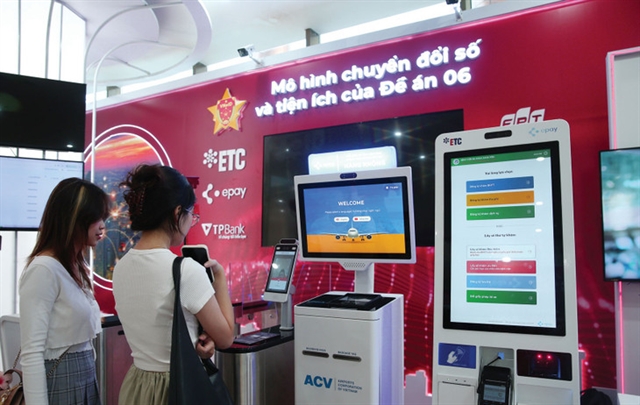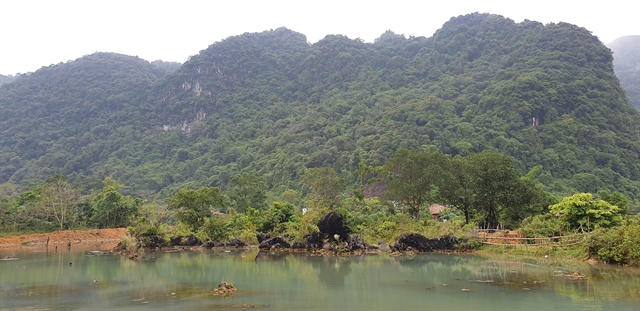 Business Beat
Business Beat


|
| Forests in Quảng Bình. This province would transfer more than 2.4 million carbon credits to earn about VNĐ235 billion in the 2023-25 period. — VNA/VNS Photo Võ Dung |
Compiled by Hoàng Hà
HÀ NỘI — Việt Nam promotes building and developing a carbon credit market to utilise its great potential for carbon absorption from forest development.
Carbon credits, also known as carbon offsets, are permits that allow the owner to emit a certain amount of carbon dioxide or other greenhouse gases. One credit permits the emission of one tonne of carbon dioxide (CO2) or the equivalent in other greenhouse gases.
2023 marked a significant milestone for the forestry sector as Việt Nam successfully sold 10.3 million forest carbon credits (10.3 million tonnes of CO2) for the first time through the World Bank (WB) for US$51.5 million, said Deputy Minister of Agriculture and Rural Development Nguyễn Quốc Trị.
The sale was part of the Emission Reductions Payment Agreements (ERPA) in the north central region signed on October 22, 2020 between the International Bank for Reconstruction and Development (IBRD) of the WB and the Ministry of Agriculture and Rural Development (MARD).
In early August 2023, the WB paid the first ERPA instalment of $41.2 million to the Vietnamese ministry, or 80 per cent of the contract.
The remaining $10.3 million will be paid after the transfer of 10.3 million tonnes of CO2 is completed.
The Việt Nam Forest Protection and Development Fund has received and disbursed all the first payment so that six north central provinces can urgently make payment plans for forest owners. Those provinces include Thanh Hóa, Nghệ An, Hà Tĩnh, Quảng Bình, Quảng Trị and Thừa Thiên-Huế. The financial resource will contribute to protecting forests and improving people's lives in these provinces.
Mai Văn Minh, director of the Department of Agriculture and Rural Development of Quảng Bình Province, said Quảng Bình would transfer more than 2.4 million carbon credits to earn about VNĐ235 billion in 2023-2025.
In 2023, Quảng Bình received VNĐ82.4 billion from transferring carbon credits - the second highest revenue among six provinces in the region, according to Minh.
In addition to the number of credits sold, the WB has confirmed the emission reduction results of the entire north central region in the first period (January 1, 2018 - December 31, 2019), reaching 16.21 million tonnes of CO2 (equivalent to 16.21 million credits).
According to the Ministry of Natural Resources and Environment (MONRE), with more than 14.7 million hectares of forests, including about 10 million hectares of natural forests, Việt Nam's forests can generate huge financial resources from the carbon credit market to re-invest in forest protection and development.
To participate in domestic and global carbon markets, the Forestry Department proposes to pilot the transfer of emission reduction results for potential areas.
The Ministry of Finance is also coordinating with MONRE to develop a project building the domestic carbon market to submit to competent authorities for consideration and approval.
Carbon credit trading also opens a new business field for companies. In September 2023, CT Group launched its ASEAN Carbon Credit Exchange Joint Stock Company (CCTPA), becoming the first Vietnamese enterprise to kick off a voluntary carbon emissions exchange.
According to Hoàng Bạch Dương, deputy chairwoman of CT Group, building a carbon market and green finance market is a vital trend to improve businesses’ competitive capacity since meeting all requirements of carbon barriers that large markets are imposing will play a decisive role for the race in the global supply chain.
The launch of the CCTPA will encourage enterprises to shift to cleaner technologies which help reduce carbon emissions and achieve Việt Nam’s net-zero emissions goal by 2050.
Tăng Thế Cường, director of MONRE's Department of Climate Change, said that developing the carbon market in Việt Nam will contribute to implementing the goals of reducing greenhouse gas emissions and promoting the development of low-emission technology.
However, there are still many obstacles that make localities with forests as well as investors intending to invest in Việt Nam's forest carbon credits, still very cautious.
At present, many localities have potential in exploiting forest carbon credits, but there are still no specific instructions on collecting and selling carbon credits.
The forested area of nearly 500,000 hectares, covering more than 60 per cent of Quảng Nam's area, will generate one million carbon credits on average each year. So Quảng Nam can earn over VNĐ100 billion from selling the forest carbon credits.
This revenue is much larger than the revenue from forest environmental services. Not only forest owners but also local authorities have high hopes for the tradable carbon credits.
Over the next 10 years, Quảng Nam's natural forest area is expected to increase by 20 per cent, contributing to the country's overall emission reduction goal.
Hồ Quang Bửu, vice chairman of the People's Committee of Quảng Nam Province, said the authorities and also the forest owners hope that the Government will create a clear legal corridor for trading carbon credits.
Tuyên Quang Province now has nearly 426,000 hectares of forests, offering huge potential in trading forest carbon credits.
However, this province has had difficulty carrying out forest carbon credit trading activities due to the lack of regulations on processes, procedures, responsibilities of relevant parties, and financial mechanisms of a forest carbon credit trading project.
Nguyễn Tuấn Quang, deputy director of MONRE's Climate Change Department, said that to promote the development of the carbon market in Việt Nam, the tasks are now to develop regulations on carbon credit management and trading; establish a national registration system for carbon credits; and develop a list of activities and measures to reduce greenhouse gas emissions for encouraging the exchange of carbon credits with international partners.
It should also negotiate to have agreements or contracts with international partners on exchanging carbon credits, resulting in reduced greenhouse gas emissions.
Along with that, Việt Nam needs to prepare professional human resources, infrastructure and necessary conditions to operate the greenhouse gas emission quota and the carbon credit exchange, according to Quang. It should have programmes on the development of voluntary and compliant carbon markets.
Meanwhile, Trần Quang Bảo, director of the Việt Nam Department of Forest, said according to Government Decree 06/2022/NĐ-CP, Việt Nam will pilot operation of carbon credit exchange in 2025 and officially run this market in 2028.
Accordingly, from now until the end of 2027, Việt Nam must focus on developing regulations on carbon credit management and exchange of greenhouse gas emission quotas and carbon credits.
It must develop regulations on operating the carbon credit market, pilot implementation of the mechanism for exchanging and clearing carbon credits in potential areas in accordance with domestic laws and provisions of international conventions to which Việt Nam is a member.
Vũ Trung Kiên, director of the Centre for Climate Change Response Support, said the carbon credit market is an important source of capital to help businesses and the country's economy transition from brown (resource-based) to green, both reducing greenhouse gas emissions and creating motivation and profits for businesses and the country.
Therefore, to build the carbon credit exchange, it is necessary to improve the domestic legal framework in accordance with international requirements, said Kiên.
In addition, it should have more financial resources and technological innovation. These are also huge challenges, Kiên said. — VNS




